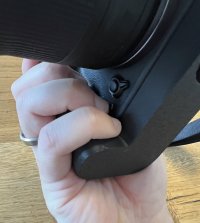Gopro (with external gopro housing) should be everyone's first choice as video "tends" to be easier underwater until you work out the staying alive underwater bit first. Stills on a gopro are pretty average though.
Makes sense, but no plans to get a GoPro. I definitely plan on shooting video in addition to stills.
A bunch of options for phone housings - at least for snorkeling depths eg
https://aquatech.net/collections/axisgo
Less options for scuba depths ie >10m. The hard part about phone housings is the myriad sizes and touch screen functionality. Generic size ones means that you don't have to change the housing with a new phone.
Kracken has a USD400 generic one
https://krakensports.ca/product/universal-smartphone-housing-krh08-v2/
It uses blue tooth mechanical buttons and their custom app for settings and trigger the shutter.
Shoot raw and ignore the red filter unless you are shooting video.
Vacuum port is very useful to check the o-ring seal (piece of mind).
I'll be snorkeling but also scuba diving, so I need something that works down to 40 m. I went with the SeaLife housing (similar to the Kraken in that it's also generic and uses an app to control the phone via bluetooth). Has a vacuum port, self test, moisture sensor inside, etc. The SeaLife app seems to be updated pretty frequently and the developer is quite responsive in the comments, that's always a good sign.
Add a tray for stability and lights to bring back the colour under 10m and the "investment" starts adding up

Moving to an Ikelite housing for the M6ii is USD775 + additional port/dome etc for the lens(es) you want to use. Add a tray/handles (USD150) and vacuum (USD195).... You can see how the add-ons accumulate until you wonder if you should not have got the housing for your main camera.
The biggest (if you pardon the pun) difference is the oversize with the M6ii. Easier to transport/carry and maneuver underwater.... People can get closer to subjects with a gorpro than my underwater rig.
Of course, ensure that you watch your air consumption, depth and decompression times and keep with your buddy ie stay alive

I'm fortunate that cost is not really a huge concern for me. Ease of use, features, etc. are more important. I tend to shoot manual and change settings frequently on land, and I'd rather not futz with that underwater where there the factors in your last sentence must take precedence.
The other factor for me, and a main reason I went with SeaLife, is they have a very nice ecosystem of lights and trays/arms. The reading I have done suggested that underwater is similar to portraiture in that the lighting is far more important than the camera. Adjusting ILC settings and strobe settings is more than I want to deal with, at least for the time being. As for getting a housing for my main camera, Ikelite doesn't make one for the R3 and it's not clear if they will. Also to that point, I've been told by a couple of experienced underwater photographers that, "There are two types of underwater photographers – those who have had a housing flood, and those who will have a housing flood." If I decide to use an ILC for diving, I'd likely get a housing for the R8 (Ikelite is already planning to make one, and I have the R8 on preorder).
In addition to the smartphone housing, I got a pair of
3000 lumen flood lights (dual function, with a 1500 lumen spot in addition to the flood). I also picked up
SeaLife's blue fluorescent excitation source. I have done fluorescent microscopy for three decades, so that's an aspect of marine life I'm interested to explore. The diver/physicist who collaborated with SeaLife on the fluorescent light head makes a nice custom snap-on yellow filter for the housing (to filter out reflected excitation light) that I'll swap out for the red filter.
If I do eventually move to a MILC in an Ikelite housing, the SeaLife gear can be adapted to work with it.
Thanks for the advice!





